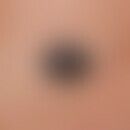Synonym(s)
DefinitionThis section has been translated automatically.
Localized (systematized but not systemic) scleroderma arranged in strips or bands with a chronic course that may last for years. It is similar to the plaque or morphea type, but is generally clinically more severe: in addition to the skin and subcutis, the deep fasciae and underlying bone areas may also be affected. Depending on the localization, the sclerosing process leads to impaired contour and function. Of note is the rare complication of linear circumscribed scleroderma under therapy with TNF-alpha antagonists (see case report and literature).
ClassificationThis section has been translated automatically.
Linear or band-shaped circumscribed scleroderma occurs in 2 clinical variants:
- Linear circumscribed scleroderma of the extremities
- Scleroderma en coup de sabre (morphea en coup des sabre), the variant of linear circumscribed scleroderma of the forehead.
Note: Hemifacial progressive atrophy(Parry-Romberg syndrome) is considered by some authors to be a particularly severe and extensive variant of linear circumscribed scleroderma. However, some authors regard it as an idiopathic, independent neuro-vegetative complex disease spanning several organ boundaries, whereby skin sclerosis is not an obligatory symptom.
You might also be interested in
ManifestationThis section has been translated automatically.
Start in early or middle childhood; 2/3 of the patients are younger than 18 years at the beginning of the disease.
LocalizationThis section has been translated automatically.
Extermities, forehead, capillitium
Clinical featuresThis section has been translated automatically.
The clinical picture of linear morphea is variable depending on the age, extent and localization of the lesions. The onset is often unspectacular with discrete, non-symptomatic, non-scaling erythema.
Over the course of months (sometimes years), there is a gradual induration of the lesions, initially without involvement of the skin appendages (follicles detectable intralesionally).
As the sclerosis progresses, subcutaneous fatty tissue, possibly underlying fascia and muscles are also affected. The areas adhere firmly to the underlying tissue. The fasciae are indurated and can tightly envelop the muscles of the extremities, but also the skeletal subalae. Carpal tunnel syndrome can occur as a typical complication if the lesion is localized appropriately. Lesional atrophy of the skin appendages (absence of follicular structures) often occurs at this stage.
If linear joint areas are affected, mobility may be restricted.
The maximum variant of joint-spanning atrophying linear morphea is pansclerotic circumscribed morphea, also known as"disabling pansclerotic morphea".
Cutaneous features of linear circumscribed scleroderma may also be clinically detectable in facial Parry-Romberg syndrome.
LiteratureThis section has been translated automatically.
- Duymaz A et al. (2009) Parry-Romberg syndrome: facial atrophy and its relationship with other regions of the body. Ann Plast Surg 63:457-461.
- Echenne B et al. (2007) Parry Romberg syndrome and linear scleroderma en coup de sabre mimicking Rasmussen encephalitis. Neurology 69:2274.
- El-Kehdy J et al (2021) A review of Parry-Romberg syndrome. J Am Acad Dermatol 67:769-84.
- Inoue-Nishimoto T et al. (2015) Possible association of anti-tumor necrosis factor-α antibody therapy with the development of scleroderma-like changes with lichen planus. Eur J Dermatol 25: 513-515
- J Clin Rheumatol 11: 319-322
- Mattozzi C et al. (2010) Morphea, an unusual side effect of anti-TNF-alpha treatment. Eur J Dermatol 20: 400-401
- Mertens JS et al.(2015) Disease recurrence in localized scleroderma: a retrospective analysis of 344 patients with paediatric- or adult-onset disease. Br J Dermatol 172:722-728.
- Ramírez J et al. (2012) Morphea associated with the use of adalimumab: A case report and review of the literature. Mod Rheumatol 22: 602-604
- Ranganathan P et al. (2005) Infliximab-induced scleredema in a patient with rheumatoid arthritis.
- Stewart FA et al. (2013) New side effect of TNF-alpha inhibitors: Morphea. Skinmed 11: 59-60
- Torrente-Segarra V et al. (2020) Linear localized morphea associated with golimumab in a patient with spondyloarthritis. Reumatol Clin (Engl Ed) 16:303-305.
- Yamamoto N et al. (2021) Linear morphea involving the underlying muscle. Clin Rheumatol 40:4767-4768.
Outgoing links (4)
Disabling pansclerotic Morphea ; Parry Romberg syndrome; Scleroderma and coup de sabre; Tnf-alpha antagonists;Disclaimer
Please ask your physician for a reliable diagnosis. This website is only meant as a reference.

















